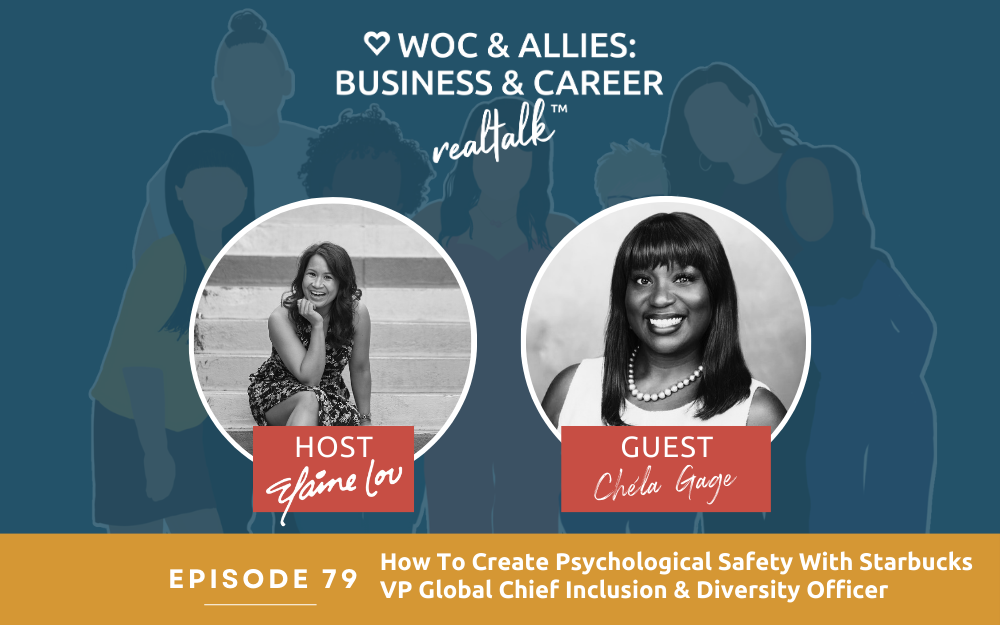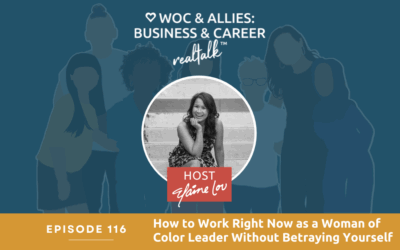Listen and Follow on Your Favorite Platform:

Picture a workplace where everyone feels valued, respected, and free to express their ideas without fear of judgment or retribution. That’s the power of psychological safety. When team members feel safe to take risks, ask questions, and challenge the status quo, magic happens. Innovation thrives, engagement soars, and performance skyrockets.
But here’s the thing: psychological safety doesn’t just happen by chance. It takes intentional effort and leadership to cultivate a culture where people feel genuinely safe to be themselves. And that’s exactly what we’re here to explore today cause there are different levels of psychological safety, and it is possible to create psychological safety.
In today’s podcast, I have Starbucks’ new VP Global Chief Inclusion and Diversity Officer, Chéla Gage, joining me. Chéla is not only a former client but also a good friend. Her greatest achievements include being an amazing wife for 20 years and a mother to 3 wonderful boys.
Chela has extensive talent and DEIB experience spanning over 25 years. She has successfully led global teams in various industries, such as high technology, automotive, and aerospace. Her leadership roles have taken her to different countries, including the U.S., Brazil, China, France, Japan, Mexico, Poland, Singapore, and the U.K.
What We Cover in This Episode:
- Challenges for Women of Color in Corporate roles
- The Importance of Creating Diversity Changes in Processes and Systems (a workshop won’t solve your diversity problems)
- Understanding The Role of External Coaches and Mentors
If you would like to see how to work with me to create a more sustainable life where you can be more present with yourself and create your own checklist of success that’s not created by society and loved ones, then schedule a complimentary legacy business and career review at elainelou.com/call
Related Podcast Episodes
Episode 28. The Importance of Trauma Informed Spaces
Episode 31. How to Advocate For Yourself asa WOC in Corporate America with Lindsey Ingram
Episode 47. Scripts and Strategies for Boundaries and Negotiation for WOC Leaders with Accion Opportunity Fund
Episode 40. Why Difficult Conversations Improve Our Life + Work Relationships with Erica Courdae and India Jackson
Resources Mentioned:
Subscribe to the Business & Career Diaries Newsletter: elainelou.com/join
Connect and follow Chela: https://www.linkedin.com/in/chelagage/
Where We Can Connect:
Apply to the Business & Career Mastermind: elainelou.com/mastermind
Schedule a Business & Career Audit call with me to see if it’s a good fit to work together: elainelou.com/call
Follow the Podcast on Apple: WOC and Allies: Business and Career Realtalk
Follow the Podcast on Spotify: WOC and Allies: Business and Career Realtalk
Follow Elaine on Instagram: @elainelou_
Connect with Elaine on LinkedIn: Elaine Lou Cartas
Check out our other podcasts for Women of Color
Follow, Rate & Review on Apple Podcasts
Are you following the WOC & Allies: Business & Career Realtalk podcast? My team and I created this podcast for accessible education for women of color and allies. When you follow the podcast, it lets podcast streaming companies know that this podcast is a podcast fellow women of color and allies should listen to. If you are enjoying the show, I would love it if you would leave me a review on Apple Podcasts. This is one of the best ways to support the show and my team, and it helps other Legacy Leaders find it! Head over to Apple Podcasts to follow, rate and review now!
Understanding Psychological Safety
At its core, psychological safety is about creating an environment where employees feel free to express themselves without fear of negative consequences. It’s about fostering a culture of trust, respect, and openness thats create safety at work.
When employees feel psychologically safe, they’re more likely to take risks, share ideas, and speak up when they see something that needs to be addressed. They’re also more likely to be engaged, productive, and committed to their work.
When staff feel unsafe psychologically, they’ll often keep to themselves, dodge risks, and clam up even when they’ve got great ideas. This kind of key insight ignored can stifle progress and trigger issues like missed chances or slowing down productivity.
The Four Stages of Psychological Safety
So, how do you create a psychologically safe workplace? According to Timothy R. Clark, there are four stages of psychological safety that organizations need to focus on to build psychological safety:
Learner Safety
The first stage is learner safety. This is about creating an environment where employees feel comfortable to engage in the learning process without fear of being judged or criticized.
When employees feel like they can ask questions, make mistakes, and learn from their experiences, they’re more likely to take on new challenges and develop new skills.
Inclusion Safety
The second stage is inclusion safety. Create an environment where everyone feels included and valued for who they are.
When employees feel like they belong and that their unique perspectives and experiences are appreciated, they’re more likely to bring their whole selves to work and contribute their best ideas.
Contributor Safety
The third stage is contributor safety. This is about encouraging employees to contribute their ideas and efforts without fear of embarrassment or retribution.
When employees feel like their contributions are valued and that they won’t be punished for speaking up or taking an interpersonal risk, they’re more likely to be proactive and innovative.
Challenger Safety
Challenger safety wraps things up in the fourth phase. It invites team members to challenge expectations and voices their thoughts openly, with no fear of repercussion following constructive criticism. This is important to maintain psychological safety.
When employees feel like they can respectfully disagree with others and raise issues that need to be addressed, they’re more likely to help identify and solve problems before they become bigger issues.
Creating a Psychologically Safe Workplace
Creating a psychologically safe workplace isn’t easy, but it’s essential for any organization that wants to thrive in today’s fast-paced, ever-changing business environment.
As a leader, there are several key things you can do to foster psychological safety on your team:
Establish Trust
Building trust among team members is crucial for psychological safety. When employees trust each other and their leaders, they’re more likely to take risks, share ideas, and work together effectively.
One way to build trust is by being transparent and honest in your communication. Share information openly, admit when you don’t know something, and follow through on your commitments.
Encourage Open Communication
Promoting open communication is another key aspect of creating a psychologically safe workplace. Encourage employees to ask questions, share their thoughts and ideas, and provide constructive feedback.
Engaging your team effectively starts with asking questions that prompt detailed responses. Keep genuinely engaging, listen actively to each person, and focus on building a space where everyone feels heardanderingopen-openfield.%.
Embrace Diversity and Inclusion
Embracing diversity and inclusion is also essential for psychological safety. When employees feel like they belong and that their unique perspectives are valued, they’re more likely to bring their whole selves to work.
Make sure your hiring practices prioritize diversity and that your workplace culture is inclusive of all individuals, regardless of their background or identity. Celebrate the strengths that each team member brings to the table.
The Role of Leadership in Psychological Safety
As a leader, you play a critical role in creating and maintaining a psychologically safe workplace. Your actions and behaviors set the tone for the rest of the team.
Here are a couple of specific things you can do to ensure your team feels safe and supported:
Soliciting Feedback
Actively seek feedback from your team members to understand their concerns and ideas. Create regular opportunities for employees to share their thoughts, whether through one-on-one meetings, team discussions, or anonymous surveys.
When you receive feedback, listen carefully and take it to heart. Show that you value your team’s input by acting on their suggestions and addressing their concerns.
Addressing Microaggressions and Gaslighting
Be vigilant about addressing microaggressions and gaslighting in the workplace. These subtle forms of discrimination and manipulation can quickly erode psychological safety.
If you witness or hear about incidents of microaggressions or gaslighting, address them immediately. Make it clear that such behavior is not tolerated and take appropriate action to hold individuals accountable.
Benefits of Psychological Safety in the Workplace
Creating a psychologically safe workplace isn’t just the right thing to do – it’s also good for business. When organizations prioritize psychological safety, they experience a range of benefits:
Increased Innovation
A psychologically safe environment encourages out-of-the-box thinking and calculated risk-taking. When employees feel like they can share their wildest ideas without fear of judgment or retribution, they’re more likely to come up with creative solutions to complex problems.
Some of the most innovative companies in the world, like Google and Pixar, prioritize psychological safety as a key driver of their success.
Higher Employee Engagement
Employees who feel psychologically safe are more likely to be engaged and committed to their work. They’re more likely to go above and beyond, take ownership of their projects, and feel a sense of pride in their contributions.
In contrast, employees who don’t feel psychologically safe are more likely to be disengaged, unmotivated, and looking for opportunities elsewhere.
Organizational Success
Companies with high degrees of psychological safety often see better overall performance. They’re more agile, adaptable, and resilient in the face of change and uncertainty.
When employees feel safe to speak up, challenge the status quo, and take calculated risks, organizations are better positioned to identify and seize new opportunities, navigate challenges, and achieve long-term success.
Challenges in Implementing Psychological Safety
Creating a psychologically safe workplace is no easy feat. It requires a significant shift in mindset and culture, which can be met with resistance from employees who are used to traditional work environments. Change is hard, and it’s natural for people to feel uncomfortable when asked to step outside their comfort zone.
Resistance to Change
One of the biggest challenges in implementing psychological safety is overcoming resistance from employees who are accustomed to the status quo. They may fear that speaking up or challenging the norm will lead to negative consequences, such as being labeled as a troublemaker or losing their job. To address this, leaders must communicate the benefits of psychological safety clearly and consistently. They need to model the behavior they want to see and create a culture where it’s safe to take risks and make mistakes. Celebrating small wins and recognizing employees who demonstrate psychological safety can also help to build momentum and encourage others to follow suit.
Underrepresented Groups
Another challenge is ensuring that underrepresented groups, such as women and minorities, feel psychologically safe in the workplace. These groups often face additional barriers and biases that can make it harder for them to speak up and be heard. To overcome this, leaders must actively seek out and listen to diverse perspectives. They need to create an inclusive environment where everyone feels valued and respected, regardless of their background or identity. This may require additional training and support for managers and employees to help them recognize and address unconscious biases.
Psychological safety is not about being nice. It’s about giving candid feedback, openly admitting mistakes, and learning from each other.
— Amy Edmondson (@AmyCEdmondson) April 30, 2020
As Amy Edmondson, the Harvard Business School professor who coined the term “psychological safety,” points out, it’s not about being nice or avoiding difficult conversations. It’s about creating an environment where people feel safe to give candid feedback, admit mistakes, and learn from each other. This requires a high level of trust and openness, which can be challenging to achieve in organizations with a history of hierarchy and fear-based management.
Practical Tips for Employees to Foster Psychological Safety
While leaders play a crucial role in creating a psychologically safe workplace, employees at all levels can also contribute to a supportive and inclusive culture. Here are some practical tips for fostering psychological safety in your own work environment:
Practice Active Listening
One of the most important skills for building psychological safety is active listening. When a colleague shares an idea or concern, give them your full attention and try to understand their perspective. Avoid interrupting or dismissing their thoughts, even if you disagree. By showing that you value their input, you can help to create a culture of trust and respect.
Offer Constructive Feedback
Giving feedback can be challenging, especially if it’s negative. However, constructive feedback is essential for growth and improvement. When offering feedback, focus on specific behaviors or actions rather than personal attributes. Use “I” statements to express your own perspective, rather than making accusations or generalizations. And always offer suggestions for improvement alongside any criticism.
Support Colleagues
Finally, one of the most powerful ways to foster psychological safety is simply to support your colleagues. When someone shares an idea or takes a risk, show your appreciation and encouragement. If someone makes a mistake, offer your help and understanding rather than judgment or blame. By being a supportive and empathetic teammate, you can help to create a culture where everyone feels valued and included.
Resources for Further Learning on Psychological Safety
If you’re interested in learning more about psychological safety and how to create a supportive and inclusive workplace, there are many great resources available. Here are a few recommendations:
The Fearless Organization: Creating Psychological Safety in the Workplace for Learning, Innovation, and Growth by Amy Edmondson – This book provides a comprehensive overview of psychological safety and how to create it in your organization.
The 4 Stages of Psychological Safety by Timothy R. Clark – This framework outlines the four stages of psychological safety and how to progress through them.
Chayla Gage on Psychological Safety at Starbucks – This podcast episode features insights from Chayla Gage on how Starbucks has successfully implemented psychological safety.
By exploring these resources and putting the principles of psychological safety into practice, you can help to create a workplace where everyone feels safe, valued, and empowered to do their best work.
Conclusion
Psychological safety is the foundation of high-performing teams. By fostering an environment where people feel safe to speak up, take risks, and be themselves, you unlock the full potential of your workforce. Trust deepens, collaboration flourishes, and innovation becomes the norm.
But remember, building psychological safety is an ongoing journey, not a one-time destination. It requires consistent effort, authentic leadership, and a genuine commitment to valuing every voice at the table.
So, keep the conversation going. Keep listening, learning, and growing together. Because when psychological safety thrives, so does your organization. And that’s a powerful competitive advantage in today’s ever-changing world.
If you would like further support in your career, business, or leadership, my team and I would love to support you in creating a sustainable life through our coaching services! You can schedule a 30-minute legacy business or career review call with me to see if it’s a good fit to work together, and you’ll receive 3 action-items from me.




